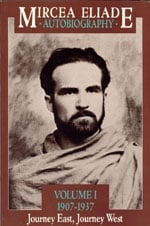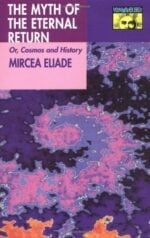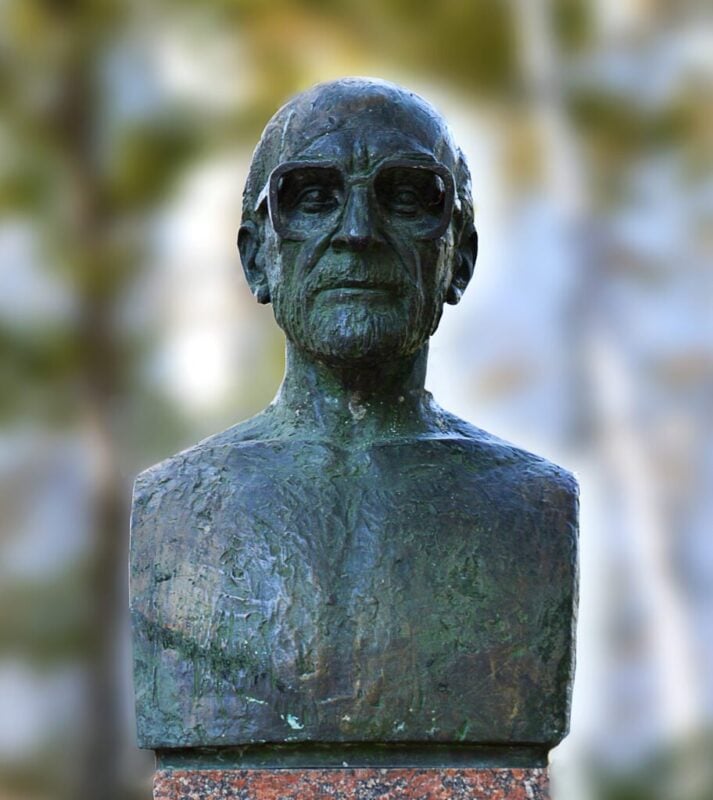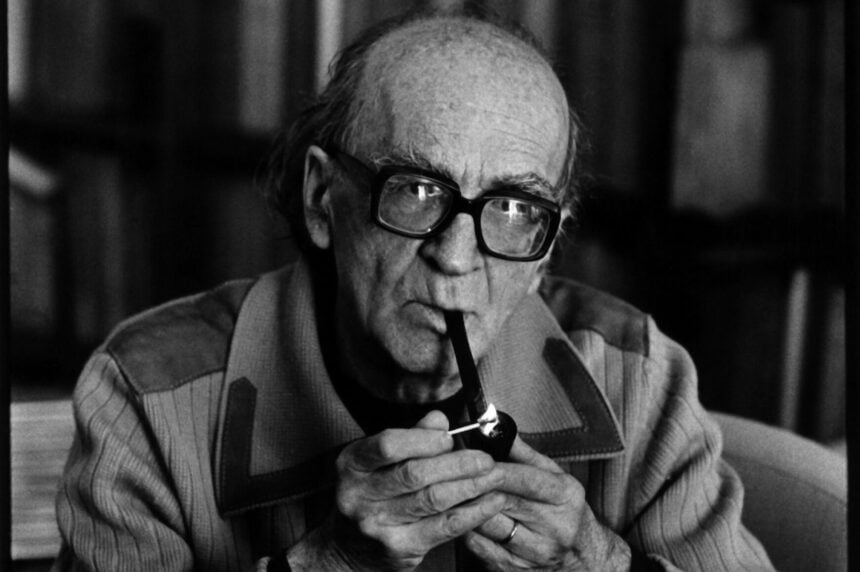Historian of the Sacred and the Profane
For those who reached intellectual maturity following World War II, Mircea Eliade (1907–1986) should be a familiar name, for he was the preeminent historian of religion, especially “archaic” religion, in the 20th century. More recently, Eliade’s scholarly reputation has been tainted by numerous attacks, both here in the U.S. and abroad, for his association in the 1930s with Romania’s right-wing revolutionary political party, the Legion of the Archangel Michael.
While these attacks have been based largely on false claims and politically motivated innuendo, they have obscured the value of Eliade’s groundbreaking work on the morphology of the sacred both in primitive religious experience and in the transcendental religions that emerged in the so-called Axial Age, from roughly 800 B.C. to 200 B.C. Indeed, it is primarily by way of Eliade and his precursor in the study of religion, Rudolf Otto, that our current understanding of religious consciousness has been freed from a reductivist-materialist model. Moreover, Eliade’s striking insights into the nature of “sacred time” challenge decisively our modern understanding of historical consciousness.
Eliade was a man who knew something about the “terror of history,” a phrase he employed extensively to describe the meaningless and often violent disruptions of secular historical experience. The son of a Romanian army officer, he spent his adolescence in Bucharest during World War I and witnessed German zeppelins bombing the civilian quarters of the city in the autumn of 1916. As he grew into adulthood in the 1920s and ’30s, he participated in the turbulent rise of Romanian nationalism—a force that eventually led to dictatorship and even inspired a Romanian alliance with German National Socialism in the early 1940s.
If what is “real” for archaic man is that which exists or is enacted in sacred time, then time which falls outside the sacred—profane time—is terrifying because it is meaningless.
At the University of Bucharest, Eliade studied philosophy and the history of religion. Among his professors was Nae Ionescu, one of most controversial and charismatic thinkers in Romania. A professor of metaphysics, Ionescu was well-known for his lectures, such as “The Epistemological Function of Love” and “The Phenomenology of Religious Practice.” Because of his creative thinking, students flocked to his classroom. An admiring Eliade wrote in 1937 that Ionescu
created a style which his students imitated: direct speech, short sentences, humorous illustrations…. Ironic rather than prophetic, familiar rather than solemn. Nae Ionescu does not dominate like an oracle nor thrill like a Pythia. His word conquers—and his thought troubles.
Eliade became a disciple of Ionescu, and they formed an enduring friendship, one which eventually resulted in Eliade’s appointment in 1933 as a lecturer at the university. It was largely Ionescu’s influence that shaped some of Eliade’s philosophical assumptions, especially the former’s rejection of the positivist tradition that, in his view, had long poisoned European thought. For Ionescu, rationality had its place and its appropriate methods for dealing with time and space, but he insisted that the realms of “essences” and of “faith” could not be fully apprehended by rational means. Eliade embraced this point of view and never deviated from it.
He also shared Ionescu’s belief in the destiny of the young Romania—a nation that both men believed was destined to play a unique historical role. Like his mentor, Eliade publicly expressed sympathy for the cultural aims of the Legion of the Archangel Michael, sometimes known simply as the Legion. Founded by the far-right politician Corneliu Codreanu in 1927, the Legion initially aimed at civic, cultural, and Christian spiritual renewal while focusing especially on Romanian youth. By 1930, however, the movement had spawned a military wing known as the Iron Guard, and its inner circle, including Codreanu, exhibited fascist leanings.
What is not well understood is the appeal of the Legion for thousands of young Romanians like Eliade. After World War I, Romania was redrawn to incorporate most of what had been known as Greater Romania. This new state included disputed territories like Transylvania, Bukovina, and Bessarabia. Under the rule of King Ferdinand I, the new Romania was administered by the National Liberal Party (NLP), which instituted a number of reforms intended to consolidate the power of the bourgeoisie while appeasing the hopes of the millions of peasants in the incorporated territories by instituting universal male suffrage. Thousands of the brightest sons of peasant stock flooded into the Romanian cities, lured there by the promise of education in the universities and jobs in the NLP bureaucracy. But the number of such jobs was limited, and the economic dislocation of the 1920s exacerbated the problem.
Codreanu, the son of a provincial schoolteacher, recognized the frustrated ambitions of the peasantry and sought to appeal not only to their hopes of higher economic status but also to their ethnic pride and deeply rooted Orthodox faith. Thus the Iron Guard became, as some have claimed, a messianic cult. At the core of Codreanu’s radically nationalist vision was the conviction that several ethnic minorities—especially Hungarians, Bulgarians, and Russians—threatened the organic unity of the Romanian state. These minorities, or their intellectual elites, had achieved positions of power within the national bureaucracy and were generally opposed to the organic nationalism advocated by the Legion. Equally under suspicion were the Jews, who had for many decades monopolized key positions in the professions and in the apparatus of the government (even before the rise of the NLP). Jews were disproportionately present in the communist movement as well, a reality that further fueled the Guard’s anti-Semitism.
As Eliade’s biographer Mac Linscott Ricketts (Mircea Eliade: The Romanian Roots, 1907–1945) has noted, even circa 1937, when Eliade wrote a handful of articles favorable toward the Legion, he “never gave any indication that he sanctioned the anti-Semitism preached by the Guardists.” Nor was he particularly opposed to the presence of ethnic minorities, though he did see a danger to his country if minorities refused to assimilate.
What is also striking in these articles, mostly published in the journal Vremea and in a handful of Legionary newspapers, is Eliade’s growing dissatisfaction with democracy, which he considered alien to Romanian traditions and character. Eliade viewed democracy as the degraded and secular offspring of the Western European Enlightenment and therefore incompatible with Romania’s Orthodox religious history. Eliade began to entertain the possibility of a genuine revival of “Romanianism” by way of a dictatorship resembling the Mussolini regime in Italy. As for Hitler and the National Socialists, Eliade repeatedly denounced them in numerous publications throughout the 1930s.
The chief problem with Eliade’s political writing of the late 1930s may be its naivete. He failed to see that, given the political extremism of the period, any open approval of Legionary nationalism would be seen as aiding and abetting the rise of the Iron Guard and its campaign of ethnic and anti-Semitic cleansing.

Not surprisingly, Eliade was detained for four months in 1938 by the authoritarian regime of King Carol II after the king had banned all Romanian political parties, including the Guard. When asked to sign a declaration of disassociation from the Legion, he refused. In Journey East, Journey West (1981), the first volume of his autobiography, he stated that to sign such a document would have been a betrayal of Nae Ionescu and friends in the Legion who were being “prosecuted and persecuted unjustly.”
This was another stage in Eliade’s long personal experience of the terror of history. What followed was an extended period of exile. In his 1953 “Autobiographical Fragment,” he wrote that during his final years in Romania, he seemed to be “wandering through a labyrinth,” a metaphor that he would later use in his Patterns in Comparative Religion (1949) to denote a realm of “hostile spirits and death.” When he left Romania in 1940, he would never return (aside from one brief visit in 1942), largely because post-war Communist rule there made such a return impossible. He spent the war years first in London as a cultural attaché, then in Lisbon in the same capacity beginning in 1942, when, among other things, he composed his much-acclaimed Portugal Journal (which remained unpublished until 2001). During the war, he was able to travel to Germany, where he met with political philosopher Carl Schmitt, whose work he admired.

Eliade’s wanderings continued after the death of his first wife, Nina, in 1944, when he was able to secure a teaching position in Paris. There, he made serious progress on the two major books that would appear in 1949—the aforementioned Patterns and The Myth of the Eternal Return. A number of his key ideas coalesced in these works, though they had, in fact, been germinating since 1933, when he completed his first book, Yoga: Immortality and Freedom, after spending three years in India studying Hindu ritual and cosmology.
That sojourn convinced Eliade that religious experience could be profitably studied in cross-cultural fashion to reveal a common underlying morphology. More importantly, in the 1930s, he had already begun to distinguish his own understanding of the place of religious ritual and symbolism in archaic cultures from the predominant sociological approach of that era: the functionalism of Émile Durkheim and his followers.
For Durkheim, especially in The Elementary Forms of Religious Life (1912), primitive religion was seen as a mechanism for producing social cohesion and control. By contrast, Eliade refused such a reductive approach and sought to understand religious experience on its own terms as an encounter with the sacred. Central to his approach is the concept of hierophany, a term he coined to signify anything that manifests a “modality of the sacred”—an object, a rite, a symbol, a place, a narrative or myth, and so on.
Depending on the context, almost anything could be a hierophany, but, as Eliade notes in Patterns, “The dialectic of a hierophany implies a more or less clear choice, a singling-out … [a] clear-cut separation of this thing which manifests the sacred from everything else around it.” That “everything else” is the realm of the profane, though paradoxically the sacred manifests itself through the profane, “camouflaged,” as it were. Thus archaic religion is a merger of “sacred and profane, being and non-being, absolute and relative, the eternal and the becoming.”
“Myth” is often equated with the false or fictitious, but for Eliade, a myth conveys an archetypal truth or “paradigmatic model.” In Eternal Return, he explores a sacred paradigm that is among the most universal of myths. It rests upon a fundamental “ontological conception: an object or an act becomes real only insofar as it imitates or repeats an archetype” first established “in illo tempore” (or “in that time,” the phrase Eliade used to describe prehistory).

The encounter with the sacred is, in this sense, always a return to origins. Perhaps the best examples of this are the ritual enactments associated with the New Year in hundreds of ancient cultures. Such calendar rites demonstrate that the terror of history is already a profound ontological concern for archaic man. If what is “real” for archaic man is that which exists or is enacted in sacred time, then time which falls outside the sacred—profane time—is terrifying because it is meaningless. To fall out of sacred time is to fall into non-being or spiritual death. It is not simply that historical or secular time is subject to random violence or chaotic dislocations; rather, its very “irreversibility” threatens man’s place within the sacred order. Contrasting archaic with modern man, Eliade states that “archaic humanity … defended itself, to the utmost of its powers, against all the novelty and irreversibility which history entails.”
The final chapter of Eternal Return is Eliade’s most penetrating analysis of the theme of the terror of history. He speaks at length of the modern intellectual’s intransigent historicism, his curious faith that the irreversibility of history is his guarantee of freedom and autonomy. In other words, it is the very irreversibility of “profane history” that gives him the freedom to shape himself and the world to conform to his own will. From this modern perspective, archaic man was trapped in endless repetition and enclosed within his fear of movement and spontaneity.
But, as Eliade notes, the more that modern man emancipates himself from the ancient sacral order, the less defense he has against the terror of history, against the anxiety that arises out of the irreversible movement of profane time and its existential emptiness, compounded by its inexplicable suffering and violence. Sensing this terror, he is reduced to seeking an immanent escape from history in messianic political religions or in any number of degrading distractions.

In The Sacred and the Profane (1957), published a year after Eliade took up a position at the University of Chicago, he speaks of the modern irreligious individual who assumes “a new existential situation; [who] regards himself solely as the subject and agent of history.” Modern, secular man “makes himself, and he only makes himself completely in proportion as he desacralizes himself and the world.”
For such a man, the sacred is something to be feared because it “is the prime obstacle to his freedom .… He will not be truly free until he has killed the last god.” Yet, Eliade insists, nonreligious man “has been formed by opposing his predecessor .… He recognizes himself in proportion as he ‘frees’ and ‘purifies’ himself from the ‘superstitions’ of his ancestors.” He is an “inheritor,” and “cannot utterly abolish his past, since he himself is a product of his past. His existence thus becomes a continual series of “denials and refusals,” and he is “haunted by the realities he has … denied.”
Eliade never suggested that for historical man there could be any possibility of returning to the sacral “paradise” of the ancients, but in Eternal Return, he does suggest a “possibility of freedom that does not exclude God.” While he was a historian and not a theologian or an apologist, he reminds us that the ancient “horizon of archetypes and repetition was transcended, for the first time, by the advent of Judeo-Christianism, which introduced a new category into religious experience: the category of faith.”
For archaic man, faith was unnecessary, Eliade wrote. Archaic man lived embedded at every turn in a sacralized cosmos. Belief or unbelief were nonsensical alternatives. The desacralization of the natural world was, of course, initiated by the advent of monotheism, but Christianity, at least, absorbed and purified many archaic hierophanies—primarily in the form of the sacraments—and preserved in its worship a powerful sense of sacred place.
Most importantly for present readers, Eliade writes that Judeo-Christianity offers to the man of faith a true creative freedom, “a new formula for man’s collaboration with the creation.” It is only this freedom, suggests Eliade, that can “defend modern man from the terror of history.” Judeo-Christianity preserves the modern sense of history in which each moment in time has a unique and unrepeatable value, yet this idea of history is sacralized, enfolded within a providential order. Thus the man of faith cooperates with the Creator to bring about the fruition of a design established, as St. Paul wrote, “before the foundation of the world.”
Eliade was always reticent to speak about his personal faith, but there are suggestions scattered throughout his works that he remained at some level attached to the Orthodox tradition he had known in Romania and which exhibited to a greater degree than Western Christianity the transrational encounter with the sacred that he spent a lifetime exploring.
Top image: Romanian writer and essayist Mircea Eliade at home during a portrait session held on Sept. 30, 1978, in Paris, France. (Photo by Ulf Andersen / Getty Images)

Leave a Reply